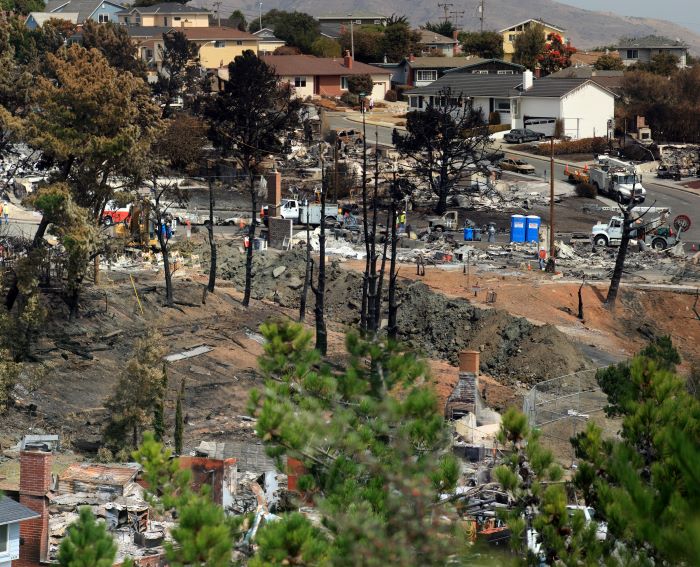The federal government and a midstream organization spent years battling over rules that would have changed the way every natural gas pipeline in the U.S. is maintained and operated, with potentially billions in company budgets on the line.
But when the fight ended with a court ruling in August, there was little to mark the conclusion of a massive U.S. Department of Transportation (DOT) undertaking to examine and rewrite the rules governing pipeline safety standards. Which means it’s possible that the process will continue.
There are roughly 2.7 million miles of natural gas gathering, distribution and transmission lines in the U.S., all of them regulated by local, state and federal agencies, including the Pipeline and Hazardous Materials Safety Administration (PHMSA), a division of the DOT.
The PHMSA published a long list of new safety standards in July 2022. It was the end of a process that, like other reform efforts, began with a disaster.
On Sept. 9, 2010, a 30-inch-diameter natural gas pipeline in San Bruno, California, ruptured and exploded, killing eight people, injuring 66 and destroying or damaging more than 100 homes.
It took the pipeline’s operator, Pacific Gas and Electric (PG&E), 95 minutes to shut off the flow. Five years later, PG&E agreed to pay a $300 million fine levied by the California Public Utilities Commission.

A nationwide review of the pipeline safety regulations was underway by 2011, mandated by Congress. Updating rules that were decades old was a monumental effort between the government and the midstream sector, according to the Interstate Natural Gas Association of America (INGAA), an industry group.
PHMSA and INGAA worked on a back-and-forth process that went well into the next decade. In 2016, both INGAA and API criticized the new rules that were taking shape. The organizations claimed PHMSA had both badly underestimated the compliance cost and overestimated the benefits of the new regulations.
The complaint would be repeated.
In 2022, PHMSA published its “final rule” that consisted of hundreds of highly technical regulations and requirements. While the government had worked with industry groups throughout the process, INGAA and its supporters considered five new rules as overreaching and unfair and petitioned the U.S. Court of Appeals, D.C. Circuit for relief.
The court struck four of the rules, agreeing with INGAA that PHMSA had not provided an adequate cost-benefit analysis proving the new regulations were worth the effort.
"For one rule, PHMSA failed to analyze the costs of implementing it altogether,” noted RBN analyst Sheela Tobben in a look at the ruling.
Law firm K&L Gates gave a detailed breakdown of the disputed rules. The court ruled that PHMSA failed to give a proper cost-benefit analysis for standards involving pipe welds, cracks, dents and corrosion.
INGAA had especially fought the new crack standard.
Cracks in a pipeline can cause failures. PHMSA sought to raise the standard of when a crack must be immediately repaired, as opposed to monitored.
“The court rejected PHMSA’s arguments that the standard was necessary for safety and that it was not obligated to consider these impacts separately, concluding that the standard must be vacated because of PHMSA’s failure to provide a reasoned cost-benefit analysis for the standard,” Gates wrote in the analysis.
The court also took PHMSA to task for contradictory language in the proposed rules regarding corrosion standards, when the agency stated that compliance would both add costs and not add costs.
“We thus cannot discern the agency’s reasoning: Does the standard impose no costs at all or does it impose some costs that cannot be calculated?” the appeals court wrote in its appeal. “The agency’s explanation contradicts itself and thus fails to meet the requirement of a reasoned cost-benefit analysis.”
Starting over
After the ruling, INGAA released a statement to Oil and Gas Investor praising the decision.
“INGAA is pleased with the outcome of this case. We look forward to working with PHMSA on continuing our efforts to improve pipeline safety, building upon the alternatives we proposed throughout the rulemaking process,” said Ben Kochman, INGAA’s director of pipeline safety policy.
Though the rulemaking process may eventually grind on, the next move will be PHMSA’s. The agency must decide whether to restart the rules-making process over the four rules the court invalidated.
Analysts noted that the process would not last as long for the next round if PHMSA only focuses on the four regulations, as opposed to the entire natural gas safety code.
“We expect that PHMSA will make another attempt to advance these now-vacated regulations, as the agency views them as critical to pipeline safety,” Gates wrote. “The agency will need to provide a clear statement of the cost-benefit analysis for each regulation to cure the errors highlighted by the D.C. Circuit.”
Other organizations called for a better, more efficient rule-making process overall. Twelve years was too long, the GPA Midstream Association said in a statement.
“Operators have demonstrated the ability to manage risk with far more precise systems and technologies than what existed when the code was initially passed more than 50 years ago,” the group wrote.
Recommended Reading
Energy Technology Startups Save Methane to Save Money
2025-03-28 - Startups are finding ways to curb methane emissions while increasing efficiency—and profits.
Kelvin.ai the 'R2-D2' Bridging the Gap Between Humans, Machines
2025-03-26 - Kelvin.ai offers an ‘R2-D2’ solution that bridges the gap between humans and machines, says the company’s founder and CEO Peter Harding.
NatGas Positioned in a ‘Goldilocks’ Zone to Power Data Centers
2025-03-26 - On-site power generation near natural gas production is the tech sector's ‘just right’ Goldilocks solution for immediate power needs.
AI Moves into Next Phase of E&P Adoption as Tech Shows Full Potential
2025-03-25 - AI adoption is helping with operations design and improving understanding of the subsurface for big companies. Smaller companies are beginning to follow in their footsteps, panelists said at Hart Energy’s DUG Gas Conference.
How DeepSeek Made Jevons Trend Again
2025-03-21 - As tech and energy investors began scrambling to revise stock valuations after the news broke, Microsoft Corp.’s CEO called it before markets open: “Jevons paradox strikes again!”
Comments
Add new comment
This conversation is moderated according to Hart Energy community rules. Please read the rules before joining the discussion. If you’re experiencing any technical problems, please contact our customer care team.






